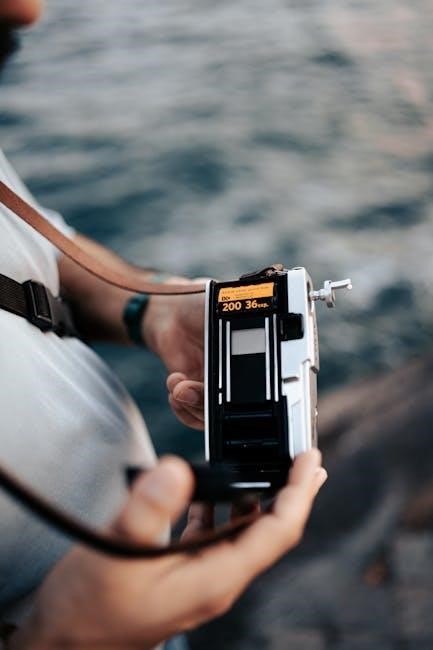Overview of Tasco Trail Cameras
Tasco trail cameras are designed to capture images and videos of wildlife. These cameras are triggered by motion‚ utilizing passive infrared sensors. They are built rugged and weatherproof for outdoor use. They offer a budget-friendly option for scouting and wildlife observation. Tasco trail cameras are compact and portable.

Understanding Your Tasco Trail Camera Model
Identifying your Tasco trail camera model is crucial for accessing the correct manual. Model numbers like 119203C‚ 119213C‚ or 119271CW help locate specific instructions. The model number is typically found on the camera’s housing. Knowing your model unlocks tailored setup and troubleshooting information.
Identifying the Model Number
Locating the model number of your Tasco trail camera is the first step towards proper setup and usage. This identifier is typically printed on a label affixed to the camera’s body. Check the front‚ back‚ or bottom of the device for a sticker or imprint containing alphanumeric characters. Common examples include “119203C‚” “119213C‚” or “119271CW.”
Once you’ve found the model number‚ make a note of it. This number is essential for finding the correct user manual online. Searching for “Tasco [your model number] manual” will yield the most relevant results. The user manual provides detailed instructions specific to your camera’s features and functions.
If the label is damaged or missing‚ consult the original packaging if available. The model number should also be printed on the box. If all else fails‚ comparing your camera’s physical appearance to images online might help you identify the model.
Identifying the correct model is vital for accessing accurate information.
Initial Setup: Batteries and SD Card
Before using your Tasco trail camera‚ install batteries and an SD card. These steps are essential for powering the camera and storing captured images/videos. Ensure compatibility and proper installation for optimal performance. This prepares the camera for initial operation.
Installing Batteries
To power your Tasco trail camera‚ you’ll first need to install batteries. Tasco recommends using 8 Energizer Lithium AA batteries for maximum battery life. Open the camera by releasing the latches on the right side. Locate the battery compartment inside the camera. Insert the batteries according to the polarity markings (+ and -) inside the compartment. Incorrect polarity can damage the camera. Ensure each battery is firmly seated. After inserting the batteries‚ close the battery compartment securely. A properly closed compartment is essential for weatherproofing.
Using lithium batteries will optimize the camera’s performance‚ especially in cold weather. Alkaline batteries can also be used‚ but their lifespan will be shorter. Avoid mixing old and new batteries‚ or different types of batteries. This can lead to reduced performance and potential damage. Regularly check the batteries’ condition. Replace them when the low battery indicator appears. With proper battery installation‚ your Tasco trail camera will be ready to capture wildlife.
Inserting the SD Card
Your Tasco trail camera uses a standard SD (Secure Digital) memory card to store photos and videos. The camera supports SD and SDHC (High Capacity) cards‚ ideally class 4 or higher. Before inserting the SD card‚ ensure the camera is powered off. Locate the SD card slot inside the camera‚ usually near the battery compartment. Insert the SD card into the slot with the correct orientation. The card will typically click into place when properly inserted.
Do not force the card if it doesn’t easily slide in. Check the orientation and try again. Using an improperly inserted card can damage the camera or the card itself. To remove the SD card‚ gently push it in to release the locking mechanism‚ then pull it out. Regularly format the SD card using the camera’s menu options to optimize performance. A formatted card ensures smooth recording and playback. Always back up your data before formatting.
Navigating the Camera’s Menu
To access your Tasco trail camera’s menu‚ first‚ ensure the camera is in setup mode. Open the camera and locate the control buttons‚ typically including menu‚ up‚ down‚ OK‚ and power buttons. Press the “Menu” button to enter the menu interface. Use the “Up” and “Down” buttons to scroll through the available options. These options might include image size‚ video length‚ sensitivity‚ time settings‚ and other configurations.
Press the “OK” button to select a menu option. Within each option‚ use the “Up” and “Down” buttons to adjust the settings. Once the desired setting is selected‚ press “OK” to save the changes. To exit the menu‚ press the “Menu” button again. Familiarize yourself with the menu structure to quickly adjust camera settings. This ensures optimal performance for your specific needs.

Setting Date and Time
To properly set the date and time on your Tasco trail camera‚ begin by powering on the device and entering setup mode. This is usually achieved by pressing the “Menu” button. Navigate through the menu options using the up and down buttons until you find the “Date/Time” setting. Select this option by pressing the “OK” button.
You will now be able to adjust the date and time. Use the up and down buttons to change the values for year‚ month‚ day‚ hour‚ and minute. Press the “OK” button to confirm each value and move to the next. Once all values are set‚ navigate to the “Save” or “Apply” option and press “OK” to save the changes. Accurate date and time stamps are crucial for organizing and analyzing captured images and videos.
Understanding Camera Modes
Tasco trail cameras typically offer several distinct operating modes to cater to various surveillance needs. The primary modes usually include “Photo‚” “Video‚” and “Hybrid” or “Dual” mode. In “Photo” mode‚ the camera captures still images when motion is detected‚ ideal for detailed observation. The resolution can often be adjusted in the settings.
“Video” mode records video clips of a set duration‚ typically around ten seconds‚ providing a dynamic view of the triggered event. “Hybrid” mode combines both functionalities‚ capturing a still image followed by a video clip‚ offering a comprehensive record. Some models may also feature a “Time-Lapse” mode‚ which automatically takes photos at set intervals‚ useful for monitoring slow changes. Understanding each mode is key to optimizing camera performance.
Troubleshooting Common Issues
Tasco trail cameras‚ while reliable‚ can encounter common issues. One frequent problem is the camera not triggering. Ensure batteries are fresh and correctly installed. Check the SD card for sufficient space and proper formatting. Also‚ verify the camera’s sensitivity settings are appropriate for the environment.
If image quality is poor‚ clean the lens and check the camera’s resolution settings. Nighttime images may suffer from insufficient lighting; consider adjusting the IR flash intensity. Should the camera fail to power on‚ try a different set of batteries. If issues persist‚ consulting the user manual or contacting Tasco support is advisable.
Always ensure the camera is securely mounted and protected from extreme weather conditions to prevent damage.

Maintenance and Care
Proper maintenance ensures the longevity of your Tasco trail camera. Regularly inspect the camera’s housing for damage‚ such as cracks or loose seals‚ which could compromise its weatherproof capabilities. Clean the lens with a soft‚ lint-free cloth to maintain optimal image quality. Avoid harsh chemicals or abrasive materials that could scratch the lens.
When not in use‚ store the camera in a cool‚ dry place‚ away from direct sunlight and extreme temperatures. Remove the batteries to prevent corrosion and potential damage to the internal components. Periodically check the battery contacts for corrosion and clean them with a cotton swab dipped in isopropyl alcohol.
Firmware updates‚ when available‚ should be installed to improve performance and address any known issues. Always refer to the user manual for specific maintenance recommendations.

Downloading and Viewing Images/Videos
After capturing images and videos with your Tasco trail camera‚ you’ll want to download and view them. The most common method involves removing the SD card from the camera. Then‚ inserting it into a compatible card reader connected to your computer. Your computer should recognize the SD card as a removable drive.
Navigate to the drive and browse the folders to locate the image and video files‚ typically in JPEG (.jpg) format for photos and AVI (.avi) format for videos. Copy these files to your computer’s hard drive for easy access.
Alternatively‚ some Tasco trail camera models may support direct connection to a computer via a USB cable. Once connected‚ the camera should appear as a removable drive. Use your computer’s file explorer to transfer the files. Standard image and video viewing software can be used to view the content.
